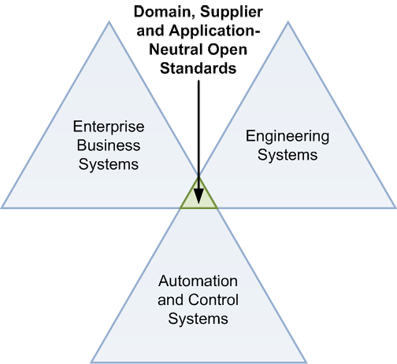My inbox has accumulated a plethora of news about open—open standards, open source, open interoperability. Open benefits implementers (end users) because so much thought and work have been done already defining models, data, messaging, and the like that integration time and complexity can be greatly reduced. Yes, integrators remain necessary. But time to production, one of the critical measures of product success, improves. Not to mention time to trouble shoot both during startup and during operation.
Without warning a short time ago, I received a call from Alan Johnston, president (and driving force for many years) of MIMOSA. I attended MIMOSA meetings for several years and served for a year as director of marketing. I was even part of the meeting that birthed the OIIE name and fleshed out the original model. I set up a number of meetings, but we were just a little premature. We needed a bit more momentum from industry and academia to get things going. The reason for Alan’s call was that momentum was growing again. Several organizations in Australia are interested, there is renewed interest from the ISA 95 committee, and the Open O&M Initiative gained new life.
So, I wound up sitting through most of four hours of introductory meeting as the various parties—old and new—talked about what they were working on and where it all needed to go to get the job done. And Alan was right. Progress has evolved. It’s time to talk about this again.
Benefits
The driving force for this work continues to be fostering interoperability and data/information flow among the major applications behind the design, construction, and operation & maintenance of a plant—engineering, operations, maintenance. Any of us who have ever searched for the current and correct information/specification of a piece of the process facing impending unplanned shutdown understand almost intuitively the critical nature of this work. (See the Solutions Architecture diagram.)

An executive summary of a white paper I wrote a few years ago still exists on my Dropbox here. The information remains relevant even though some of the organizations have changed and some technology has been updated.
OIIE
The Open Industrial Interoperability Ecosystem (OIIE) enables a shift from traditional systems integration methods to standards-based interoperability in asset intensive industries, including process industries, integrated energy, aerospace and defense and other key critical infrastructure sectors.
The OIIE digital ecosystem is a supplier-neutral, industrial interoperability ecosystem, which provides a pragmatic alternative to the status quo, enabling the use of Commercial Off The Shelf (COTS) applications from multiple suppliers, as well as bespoke applications. It is defined by a standardized Industry Solutions Architecture, which enables implementations of OIIE instances for both owner/operators and their major supply chain partners that are adaptable, repeatable, scalable and sustainable at substantially lower cost than traditional methods.
The OIIE is an outgrowth of several related industry standardization activities, each of which is addressing a part of the industries requirements for standards-based interoperability. The OIIE brings these individual efforts together, with the direct participation and support of multiple participating industry standards organizations. Major parts of the OIIE include standards associated with the OpenO&M Initiative and with ISO 15926. The OIIE uses these existing standards in combination with each other, to meet the identified systems and information interoperability requirements for use cases which are defined and prioritized by the industries which are served.
Articles I have written over the years:
Standard of standards model for asset data
Center Industrial Internet of Things
Oil and Gas Interoperability Pilot
Open O&M
OpenO&M is an initiative of multiple industry standards organizations to provide a harmonized set of standards for the exchange of Operations & Maintenance (O&M) data and associated context. OpenO&M is an open, collaborative, effort composed of diverse groups of relevant organizations and subject matter experts.
The original members of OpenO&M Initiative are ISA, MESA, MIMOSA, OAGi, and the OPC Foundation. ISA for the ISA 95 standard, MESA houses B2MML, MIMOSA has CCOM among other standards, and the OPC Foundation for OPC UA.
The purpose of last week’s conference calls was to revitalize the work, introduce additional organizations, and (importantly) new and younger participants. I left the meeting with renewed optimism that the work will continue to fruition. I am personally a globalist, but as a citizen and resident of the US, I hope that our engineers wake up to the utility of standards. Most interest in general over the past several years has been found in Asia with Europe remaining strong.
ISBM
Perhaps the component that holds everything together is the ISBM. This was previously described as ws-ISBM as it was based on SOAP and web services. The March 2020 update to ISBM v2.0 added REST and JSON support.
ISBM is an implementation specification for ISA-95 Message Service Model. It provides additional specificity that is required to enable two or more groups to develop implementations of the MSM that will properly interoperate with each other without a priori knowledge of each other. The ISBM provides a consistent set of specifications supporting both intra- and inter-enterprise activities, where a combination of functionality, security, supplier-neutrality and ease of implementation are required for industry digital transformation.




